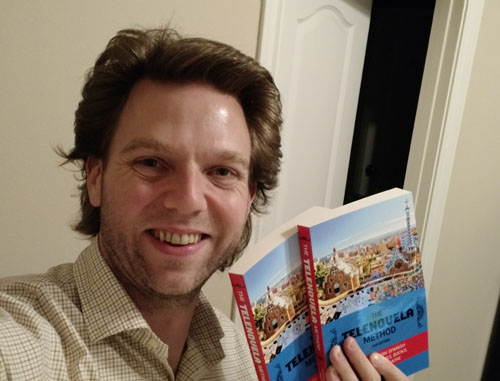The Telenovela Method, 2nd Edition
 After failing to learn a new language on five separate occasions, I taught myself to speak Spanish like a native in just six months by watching movies and TV shows, listening to music, and reading books and comics like Harry Potter and Garfield.
After failing to learn a new language on five separate occasions, I taught myself to speak Spanish like a native in just six months by watching movies and TV shows, listening to music, and reading books and comics like Harry Potter and Garfield.
This simple, easy-to-learn technique, that even the most linguistically-challenged can master literally overnight, is used by many of the most respected and skilled polyglots and language teachers in the world, and it’s never really been laid out, explained, and demonstrated in full, point-by-point, step-by-step detail until now.
The best way to learn Spanish is…
…with an experienced, professional tutor who you meet with face-to-face, 3-5 days a week for a minimum of 1 hour a day, preferably 2, and who assigns you homework which you then spend another couple hours on every day. However, very few of us can afford either the time or the money this costs. So, what to do?
The best you can. I strongly recommend a heavy emphasis on using popular media in the language you’re learning (in this case: movies, YouTube videos, music, TV shows, books, etc. in Spanish) for two reasons: you can choose things that are fun and interesting, which helps keep you engaged and prevents boredom, and because you learn to speak Spanish from native speakers who are using the language in precisely the way it’s used in conversation (when you see two characters conversing in Spanish in a movie or YouTube video, that’s how those people naturally talk, which is what you want to learn, so copy them – I’ll teach you how).
This doesn’t mean passively listening or watching, it means studying them. It means actively learning from them and that requires real work, just so those of you who are rightly sceptical of any such “passive learning” nonsense know that I’m certainly not advocating it. This does not, though, mean that it has to be at all unpleasant. It can be fun, interesting, engaging, and rewarding. It never has to be boring, tedious, or frustrating…but it very easily can be if you don’t do it right.
I tried and failed to learn various languages on at least 5 separate occasions until, finally, in my mid-20s, I taught myself Spanish entirely on my own and was able to speak fluently in just 6 months. I used the method I advocate here, still advocate, and have since used to learn French and German as well.
That is the main focus of this site: how to learn to speak Spanish on your own, that is how to teach yourself Spanish. I help you do this here with articles on methods, tips, and tricks such as this in-depth look at how many words you need to know in Spanish (depending on your goals) or this article on “how not to sound like a gringo” where I cover common mistakes beginners tend to make and how to fix them, as well as articles where I teach you Spanish directly such as with my various posts on grammar, slang, colloquial expressions, and even profanity. Not only will I give you all sorts of advice and tips on how to learn Spanish on your own but I’ll also teach a lot of it to you myself. I’ll teach you:
- Where to find native speakers who will happily correct your spoken and written Spanish online, for free (if you have internet access you can do this). This is done with something called a “language exchange”, where you help a Spanish-speaker who’s learning English with their English, and in exchange they help you with your Spanish – see here to understand why language exchanges are so useful and how to do them. Right now I recommend iTalki (reviewed here) for both language exchanges and finding paid tutors.
- How to learn Spanish from music videos (if you’re a Shakira fan you’ll really like these).
- Where to find Spanish-language videos online that include Spanish subtitles and/or a transcript (way more useful than an English translation as having the verbatim Spanish allows you to look up everything you don’t know and learn it).
- Spanish colloquialisms and slang from different countries and regions that I’ve visited (right now that includes Spain, Colombia, and Chile) or that I’ve learned from native speakers of that country (I’ve met Mexicans, Argentinians, Panamanians, and Peruvians in my travels). The main place to look for this is in my Learn Spanish for Real series that I’m constantly adding to.
- Formal grammar, such as my recent guide to regional variation in forms of address in Spanish (e.g. when to use usted vs. tú vs vosotros etc. depending on where you are).
- How to learn and use Spanish vocabulary (learn, not just memorize).
…and much more.
Please stick around, check out my most popular posts below, feel free to use the menu at the top to explore the site, and let me know what you think or if you have any questions.
Andrew
“To have a second language is to have a second soul.”
Most Popular Articles and Posts
List of Sites Where You Can Watch Spanish Videos with Spanish Subtitles or Transcripts Online
This is the Holy Grail for Spanish-learners: Spanish videos with Spanish subtitles (movies, TV shows, whatever), or with an exact transcript in Spanish of what was said (the two are functionally the same given our purpose here). Why are Spanish subtitles so...
Respond in Spanish Like a Native: Common Spanish Phrases, Expressions & Comebacks
Every language has a short list (a few dozen or so) of standard "answers" or "responses" to indicate commonly expressed sentiments (e.g yes, no, maybe, I don't know, good luck, etc.). Knowing these and being able to whip the correct one out immediately and...
Spanish Transition Words (Muletillas) and Sentence Starters: The Grease of the Language Gears
An extremely common problem amongst people learning a new language is smoothness, that ability to keep talking without herky-jerky stops-and-starts in their sentences (lots of awkward silences and "ummms" while they try to think of the right word), which is how...
Manners in Spanish – The Basics of Being Polite in Spanish-Speaking Cultures
Easy, but important...and often skipped. That's how I'd put this. We all have a certain set of manners ingrained in us since birth by our society that we do automatically, things you do to be considered polite (e.g. saying "please" and "thank you" when appropriate,...
The Spanish Subjunctive Explained: How the Subjunctive Works Plus a Mnemonic Trick to Help you Remember When to Use It (The W.E.I.R.D.O. System)
I couldn't find a picture that related to what I was writing about (I always try to do that), in this case the Spanish subjunctive, so here's a picture of my idea for an anti-gravity device based on a cat with some buttered toast on its head - what do you think? The...
List of Best Sites to Watch Spanish-Language TV/Videos Online (most are free to use)
Today I'm going to give you a list of my favorite websites that you can use to help you learn Spanish via watching television in Spanish (news, shows, telenovelas, whatever), almost all of which are entirely free. I've divided it up alphabetically by country. This...
DO YOU WANT TO Learn Spanish Painlessly?
Then you’ve come to the right place! On the website you will discover many articles, posts and resources provided by award winning author Andrew Tracey.
Learn Spanish from the News
Learn Spanish from Music Videos
Learn Spanish for Real
Learn Spanish on YouTube
The Telenovela Method, 2nd Edition
After failing to learn a new language on five separate occasions, I taught myself to speak Spanish like a native in just six months by watching movies and TV shows, listening to music, and reading books and comics like Harry Potter and Garfield.
This simple, easy-to-learn technique, that even the most linguistically-challenged can master literally overnight, is used by many of the most respected and skilled polyglots and language teachers in the world, and it’s never really been laid out, explained, and demonstrated in full, point-by-point, step-by-step detail until now.
[scrapeazon asin="B06XD5KZXV" height='300px']

Product Reviews









